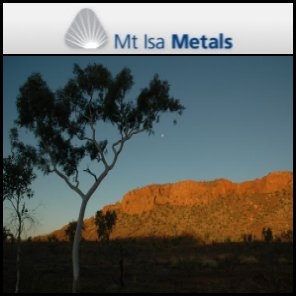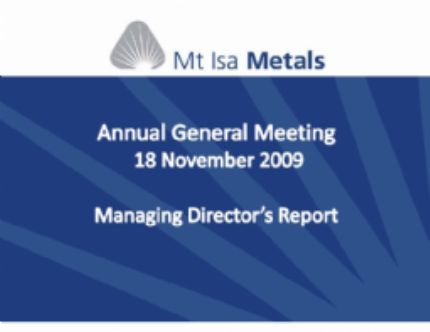
Mt Isa Metals Limited (ASX:MET) Mineralised Zone Encountered In First Drill Hole At Gregory Iron Oxide Copper Gold (IOCG) Project
Brisbane, Oct 26, 2009 AEST (ABN Newswire) - Mt Isa Metals Limited (ASX:MET) is pleased to announce the discovery of a significant zone of faulting and mineralisation in its first deep drill hole at 812 metres depth at its Gregory IOCG (Iron Oxide Copper Gold) Project in northwest Queensland approximately 230 km north of Mt Isa. The drill hole is one of two deep holes to be drilled with the aid of a A$150,000 grant from the Queensland Department of Mines and Energy under round 3 of the State Government's Collaborative Drilling Initiative (CDI).
Mt Isa Metals believes that as a result of the intensity of exploration undertaken across Australia over many years, the next generation of major new minerals projects to be discovered in Australia will be from mineral rich areas under cover. The Gregory Project tenements cover a 90 km strike extension of the heavily mineralised Mt Isa Inlier Gunpowder Trend under cover north of Mt Isa. In the Company's 2008 Prospectus, for the A$5m raising and ASX listing, MET outlined the geological models and geophysical methods it would use to explore under the cover in the Gregory Project.
The Gunpowder Trend hosts numerous, Copper, Lead-Zinc and Uranium deposits south of the Gregory Project area to Mt Isa. The Gregory Project gives MET a 'first mover advantage' into the exploration for IOCG type deposits undercover on the Gunpowder trend. MET believes that the area exhibits a number of similarities with areas in the Gawler Craton in South Australia, currently host to a number of significant IOCG deposits owned by third parties, including Olympic Dam, Carapateena, Prominent Hill, and Hillside.
Modelling of high resolution gravity and magnetic data recently acquired by MET, in conjunction with interpretation of public domain regional magnetic data, provided MET with the basis to define a number of promising geophysical targets within the Gregory Project area. Geophysics, particularly gravity and magnetics have been used as key diagnostic tools in the search for IOCG deposits in the Gawler Craton in South Australia.
The modelling supports MET's initial assessment of the project area as comprising a geologically and structurally complex basement with potential to yield several IOCG targets over a 2,055 km2 area.
While six geophysical targets have been identified, two geophysical anomalies were selected for the initial two hole drilling program at Gregory:
- The Augustus 2 target, and
- The Neumayer 1 target
Drilling commenced at the Augustus #2 target on 9 October 2009 and was completed at a depth of 812 metres on 22 October 2009.
The Augustus #2 target, located in the centre of the project area, is defined by a significant elongate residual gravity anomaly that extends over a strike length of approximately 4km and a width of 2km.
Additional gravity anomalies lie immediately north and south of Augustus #2. The gravity high is coincident with a distinct magnetic low which has been interpreted to represent destruction of an early magnetic (magnetite-rich) phase by later stage non-magnetic (hematite-rich) alteration.
The Augustus#2 drill hole (AUGDD001) is located at coordinates 380,000E 7,946,400N (GDA94) and penetrated through Mesozoic cover comprising primarily siltstones and mudstones using an open hole rotary mud technique to 515.28m. Drilling continued with diamond coring through Proterozoic basement granite.
At approximately 606 metres the drill intersected sheared and brecciated iron rich rocks containing sulphide mineralisation as disseminations, blebs and stringers over a 61 metre section through to 667 metres. The mineralisation is primarily pyrite with minor chalcopyrite (copper sulphide) accompanied by strong chlorite and in places siliceous and hematitic (jasperoidal) alteration. Mineralisation between 635m and 642m was primarily chalcopyrite in blebs and stringers. The base of the hole comprises competent medium to coarse grained grey granite/granodiorite with minor disseminated pyrite. Testing using a hand held scanner has indicated the presence of anomalous amounts of copper and molybdenum in the core.
The mineralised zone is intensely sheared and foliated with layers of magnetite chlorite and hematitic silica (jasper) bands across the 61m intersections. The zone is believed to represent a major structural (fault) feature with potential to host a significant copper system in the Gregory Project area.
MET is encouraged by the presence, over a broad zone, of shearing, brecciation, and disseminated sulphides in the drill core as such features evidence both structure and fluid flow which are essential ingredients for the formation of the target IOCG deposits. The presence of quartz veining also indicates additional phases of shearing and mineralisation, which add complexity to the mineralisation. The results obtained support the original modelling and provide further data to refine this modelling. Detailed specific gravity measurements have been taken, in order to calibrate the other gravity anomalies in the Gregory Project area.
The drill rig has moved to the Neumayer #1 target located in the northern end of the project area approximately 25km north-north east of Augustus #2. The Neumayer #1 target lies within a major crosscutting (NW-SE trending) structural corridor evident on regional scale geophysical data. MET believes that cross cutting structures are important elements in the localisation of mineralisation. Drilling will target co-incident gravity and magnetic peaks that are interpreted to be flanked by two discrete granitic bodies, or in the roof zone of one large granitic body.
MET considers that the results to date at Augustus 2 enhance the prospectivity of the other anomalies in the Gregory Project area and define a new subsurface zone of mineralisation related to the 90 km strike extension of the Gunpowder Trend covered by MET's Gregory project.
MET has split the core and is expediting the analysis of half the core over the mineralised zone. Sampling of the core is in progress and assay results will be reported as they become available.
Contact
Mr Peter Spiers
Managing Director
Ph: +61-7-3303-0624
Mob: +61-409-407-265
Mr Duncan Cornish
Company Secretary
Ph: +61-7-3303-0624
Mob: +61-407-623-302
Email: info@mtisametals.com.au
Website www.mtisametals.com.au
| ||
|




